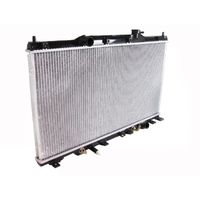How to correctly install a radiator. Vital information to ensure a safe lifespan.

Part A: Installation Procedures for replacing the radiator still in
vehicle.
1. Check the vehicle for stray current, to ensure new radiator will not be damaged. Refer below procedure to do this. Remove radiator cap or expansion tank cap, carefully, as a hot engine cooling system is under pressure.
Ensure all electrical devices are operational.
Using an Analogue amp meter (Multimeter) with low sensitivity place the negative lead on the negative terminal of the battery and the positive lead in the coolant of the radiator, ensure the lead does not touch the side of the filler neck or radiator core. Turn on all electrical devices one at a time, checking the amp meter each time a device is turned on for a reading. Carry out this process with and without the engine running. A reading of more than .04 ampere is damaging current to the engine cooling system.
The source of this stray current HAS to be removed, prior to fitting the new radiator. Failure to do so will result in premature failure of the new radiator and void the manufacturers warranty.
IF UNABLE TO REMOVE THE SOURCE OF THE STRAY CURRENT CONSULT A QUALIFIED AUTO ELECTRICIAN.
2. Loosen the drain cock of the radiator and drain all coolant from the engine cooling system.
3. Power flush the entire engine cooling system ensuring all sediment and particles are removed from all components including the heater core and overflow reservoir.
4. Refill the engine cooling system with water and an alkaline cleaning agent, turn heater on and run engine to operating temperature. This step is crucial as residue from the old coolant system will cause problems.
5. Drain engine cooling system, flush with clean water thoroughly until entire system is clean.
6. Check all engine cooling system components for wear, in accordance with the vehicle manufacturers specification. 7. Loosen and remove all hoses to radiator, unplug electric fans and remove fan shroud if applicable, remove old radiator from vehicle.
8. Fit new radiator in reverse of removal procedure and in accordance with vehicle manufacturers specification.
9. Fill engine cooling system with water and check for stray current. If stray current is present refer item 1.If no stray current is present drain engine cooling system of water.
10. Refill engine cooling system in accordance with vehicle manufacturers specification. If specification is not available refill with a coolant/inhibitor that meets or exceeds Australian Standard AS2108-97 (A) and follow the guidelines as recommended by this manufacturer for the correct mixture to fill the engine cooling system. Run the vehicle to operating temperature and recheck coolant level is correct.
Part B: Installation Procedures for replacing the radiator not in
vehicle.
1. Fit the new radiator in accordance with the vehicle manufacturers specification.
2. Refill the engine cooling system with water and an alkaline cleaning agent, turn heater on and run engine to operating temperature. Drain engine cooling system.
3. Power flush the entire engine cooling system ensuring all sediment and particles are removed from all components including the heater core and overflow reservoir.
4. Drain engine cooling system, flush with clean water thoroughly until entire system is clean.
5. Check all engine cooling system components for wear, in accordance with the vehicle manufacturers specification. 6. Fill engine cooling system with water and check for stray current. If stray current is present refer item 1 of installation procedure where radiator is still in vehicle .If no stray current is present drain engine cooling system of water.
Any stray current more than .04 ampere MUST be removed or premature failure of the new radiator will occur and void the manufacturers warranty.
7.Refill engine cooling system in accordance with vehicle manufacturers’ specification. If specification is not available refill with a coolant/inhibitor that meets or exceeds Australian Standard AS2108-97 (A) and follow the guidelines as recommended by this manufacturer for the correct mixture to fill the engine cooling system. Run the vehicle to operating temperature and recheck coolant level is correct.
NEVER MIX COOLANTS OR INHIBITORS. THE FINAL MIXTURE MAY CAUSE PREMATURE FAILURE OF THE NEW RADIATOR AND VOID THE MANUFACTURERS WARRANTY. ALWAYS USE THE CORRECT COOLANT FOR YOUR VEHICLE
STRAY CURRENT IS A VERY COMMON CAUSE OF CORROSION IN ALUMINIUM RADIATORS. STRAY CURRENT CAN CAUSE A RADIATOR TO FAIL WITHIN JUST A FEW WEEKS OF INSTALLATION. STRAY CURRENT CAN BE VERY SEVERE AND WILLVOID THE WARRANTY. SEE REVERSE FOR INFORMATION.
CHEMICAL CORROSION CAUSED BY INCORRECT FLUSHING IS A VERY COMMON CAUSE OF RADIATOR FAILURE AND WILL VOID THE WARRANTY. IF A RADIATOR LEAKS FROM ANYWHERE OTHER THAN A JOINT, IT IS CAUSED BY CORROSION.
More info on flushing:
Radiator flush appears to be a very misunderstood product, most people seem to use it as a last resort, hoping to cure some mechanical fault with their cooling system.
Radiator flush will not clear a blocked radiator.
Radiator flush was never really intended as a substitute forthe more traditional form of radiator cleaning, called rodding. The rodding process is still the only sure cure for a blocked radiator and should be carried out by a reputable radiator repair shop.
There are two basic types of radiator flush in the market place. One is a strong alkaline type and the other is acid base. Each of these products are suited to different types of cleaning. The acid based flushes are more effective for scale removal but nowhere near as effective as the alkaline flushes in the removal of oils and general organic materials. Acid based flushes usually have a reasonably severe attack rate on the metal components in the cooling system. The alkaline flushes will attack aluminium components if left in contact at elevated temperatures for extended periods of time. It is most important to strictly follow the manufacturer’s instructions regarding the time a flush should be left in the cooling system.
Tectaloy HD2 Radiator Flush is an acid based flush that is particularly beneficial in removing scale.
Tectaloy Mukowt belongs to the alkaline family of radiator flushes and is exceptionally good at the removal of oily residues, light scale deposits and general rust discolouration. Mukowt is recommended for system clean out between coolant changes or as a pre-conditioner on a vehicle running water before you change it over to a coolant or an inhibitor system. Radiator flush should be seen more in the light of preventative maintenance rather than a problem solver. Radiator flush used on a regular basis when coolants are changed will help prevent that trip to the radiator specialist for a complete radiator clean out. Even in situations where a radiator is being replaced with a recore, it is a good idea to run a flush through the cooling system, to clean out the engine block and water galleries in the head before installing the replacement radiator. A clean cooling system ensures good heat transfer and enables corrosion inhibitors to bond with the metal components to prevent further corrosion.

